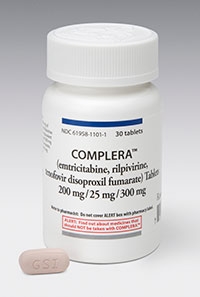Product
Complera
Approval Date
August 10, 2011
Release Date
August 12, 2011
Company
Gilead Sciences
Class
Nucleoside reverse transcriptase inhibitor + non-nucleoside reverse transcriptase inhibitor + reverse transcriptase inhibitor
Indication
For the treatment of HIV-1 infection in treatment-naïve adults
Active Ingredient
Emtricitabine/rilpivirine/tenofovir disoproxil fumarate
Agency Roster
CDM Princeton
Marketing Strategy/Execution
With Complera’s approval, Gilead finds itself in the enviable position of marketing another once-a-day HIV combo pill. Complera packages together Truvada, itself a combination of two drugs, with J&J’s Edurant. It’s the second complete single-tablet regimen that Gilead has introduced. The first, $3-billion/year Atripla, is marketed by Gilead and Bristol-Myers Squibb. Complera is priced similar to Atripla, and reps will stress its differentiation relative to the older product (see below) and that providing physicians with another single-tablet regimen option for their patients has the potential of increasing adherence while minimizing drug resistance.
Physician Outlook
Complera is the newest antiretroviral agent to enter the market. It is the second one pill, once-daily, Highly Active Antiretroviral Therapy (HAART) regimen available for HIV-1 infection. Complera is a fixed-dose combination of Tibotec Therapeutics new Non-Nucleoside Reverse Transcriptase Inhibitor (NNRTI), Edurant, and Gilead Sciences Nucleoside Reverse Transcriptase Inhibitor (NRTI) combination pill, Truvada. BMS and Gilead’s Atripla, the first one pill, once-daily HAART regimen, revolutionized the treatment of HIV through greatly enhanced convenience, compliance and low pill burden. However, Atripla is not suitable for some patients who have existing co-morbidities. It has also been associated with a relatively high incidence of CNS-related side effects. Many physicians are excited that Complera provides a one pill, once-daily alternative to Atripla. However, physician enthusiasm for Complera is somewhat tempered by less demonstrated efficacy in patients with viral loads above 100,000 copies. As with its NNRTI component, Edurant, Complera is also associated with more viral rebound and drug resistance in patients who failed Complera. These considerations have some physicians planning to choose patients with lower baseline viral loads and/or history of CNS-related comorbidities who are not suitable candidates for Atripla.
– Will Leskin, SVP, research & consulting, GfK HealthCare
Also in the Pipeline (courtesy of Adis R&D Insight)
Drug: ‘572
Manufacturer: ViiV Healthcare
Indication: HIV-1 infections
Active ingredient: Dolutegravir
Phase: III
Drug: Efavirenz/lamivudine/tenofovir disoproxil fumarate
Manufacturer: Matrix Labs
Indication: HIV-1 infections
Active ingredient: Efavirenz/lamivudine/tenofovir disoproxil fumarate
Phase: III
Drug: GS 9137
Manufacturer: Gilead Sciences
Indication: HIV-1 infections
Active ingredient: Elvitegravir
Phase: III
Drug: Kivexa
Manufacturer: GlaxoSmithKline
Indication: HIV infections (Treatment naive patients)
Active ingredient: Abacavir/dolutegravir/lamivudine
Phase: III
Drug: Elvitegravir/Truvada/GS 9350
Manufacturer: Gilead Sciences
Indication: HIV infections (Treatment naive patients)
Active ingredient: Elvitegravir/emtricitabine/tenofovir disoproxil fumarate/cobicistat
Phase: III
Source: Wolters Kluwer Pharma Solutions
Recent MM&M Coverage
Company news: Amylin, Eli Lilly, Alkermes, Gilead and J&J
Pharmacology
Complera is a fixed-dose combination of antiviral drugs emtricitabine, rilpivirine and tenofovir disoproxil fumarate.
Clinical Trials
The efficacy of rilpivirine is based on the analyses of 48-week data from two trials (ECHO and THRIVE) in antiretroviral treatment-naïve adults. In ECHO, the background regimen (BR) was tenofovir DF + emtricitabine. In THRIVE, the BR consisted of one of the following: tenofovir DF + emtricitabine or zidovudine + lamivudine or abacavir + lamivudine. Subjects were randomized to receive either rilpivirine 25mg once daily or efavirenz 600mg once daily in addition to a BR. Based on the pooled data from both trials at 48 weeks, the proportion of subjects with <50 HIV-1 RNA copies/mL receiving rilpivirine/tenofovir DF/emtricitabine (N=550) compared to subjects receiving efavirenz/tenofovir DF/emtricitabine (N=546) was 83% and 81%, respectively. The mean CD4+ cell count increase from baseline was 193 cells/mm3 for rilpivirine-treated subjects and 182 cells/mm3 for efavirenz-treated subjects.
Adverse Reactions
Insomnia, headache, GI upset, fatigue, dizziness, depression, abnormal dreams, rash; fat redistribution, immune reconstitution syndrome, lactic acidosis, severe hepatomegaly with steatosis (may be fatal).
Adults
Take with a meal. 1 tablet once daily. Renal impairment (CrCl<50mL/min): not recommended.
Children
<18 years: not recommended.
Precautions
Suspend if lactic acidosis or hepatotoxicity occurs. Women, obesity, prolonged nucleoside exposure, other risk factors for hepatic dysfunction: increased risk of toxicity. Not for treating chronic hepatitis B; test for HBV before starting therapy and monitor patients coinfected with HIV-1 and HBV during and for several months after stopping treatment (discontinuing therapy may exacerbate HBV infection). Renal impairment: monitor CrCl and serum phosphorus. May prolong QTc interval with supratherapeutic doses. History or risk of fractures or osteopenia: monitor bone mineral density (BMD); consider Vitamin D and calcium supplementation. Pregnancy (Cat. B). Nursing mothers: not recommended.








